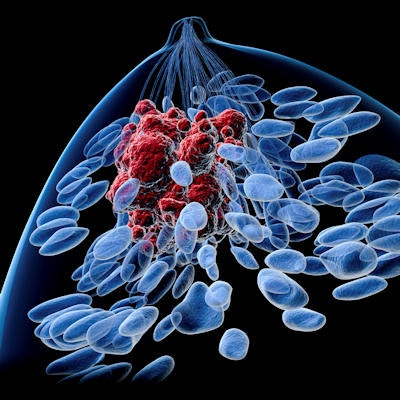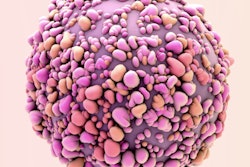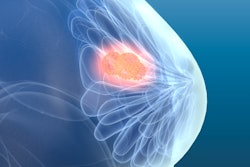
Interval breast cancers diagnosed within one year of a breast screening exam may have unique characteristics that make them particularly aggressive and deadly, according to a study published on June 30 in JAMA Network Open.
The findings come from a large, long-term study of thousands of women in the U.S. who underwent regular screening mammography. Cancers diagnosed within a year of a nonsuspicious mammogram were often larger, presented at a higher stage, and involved the lymph nodes, suggesting they may have unique characteristics that require alternative screening solutions.
"Interval cancers occurring within one year from a mammogram with negative results may have a unique biology that accounts for aggressive features," wrote the authors, led by Veronica Irvin, PhD, from the college of public health and human sciences at Oregon State University.
For their study, Irvin and colleagues used data from the Women's Health Initiative, a long-term, nationally representative study of postmenopausal women in the U.S. The Women's Health Initiative participants enrolled at one of 40 clinical centers between 1993 and 1998.
At the time of enrollment, the participants were between the ages of 50 and 79 with no personal history of breast cancer and no suspicious findings on their initial mammogram. As part of the trial, the women were split into two intervention groups: one group that received mammograms every 2.5 years and another that received mammograms yearly.
A total of 3,019 women in the intervention groups developed breast cancer during the trial. Almost two-thirds of the cancers were detected at screening, and 35% were interval cancers.
Interval cancers diagnosed within one year of a negative mammogram differed significantly from cancers found during routine screening. These breast cancers presented with more aggressive characteristics, such as large tumor size, later stage, and a higher proportion of lymph node involvement.
Women with interval cancers diagnosed within one year also had higher mortality rates than women with cancers detected at screening. That risk stayed higher even after the authors adjusted for common breast cancer risk factors, molecular subtype, histologic type, waist-to-hip ratio, intervention group, and either lymph node involvement or tumor size.
Interestingly, the authors found no significant differences in tumor characteristics or patient outcomes for interval cancers diagnosed after the one-year mark. This finding led them to believe that interval cancers diagnosed within a year might have distinct, biological characteristics from other types of breast cancer.
"For instance, increased lymph node involvement is often seen in [interval breast cancers] and cannot be accounted for entirely by delayed diagnosis but rather may be due to a unique biology," they wrote.
Based on their findings, the authors recommended more recalls or more frequent screenings for women who present for mammography with breast cancer symptoms. Alternatively, radiologists can use ultrasound or MRI as a supplemental screening method for symptomatic women or order germline genetic testing with mammography.
"This study adds to a growing body of literature that argues for the development of novel approaches to detect life-threatening cancers currently missed by mammographic screening," they concluded.



















